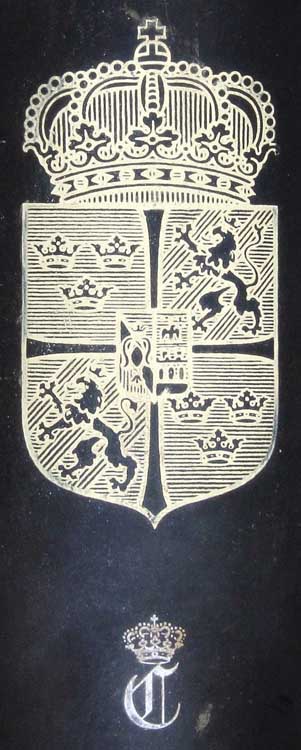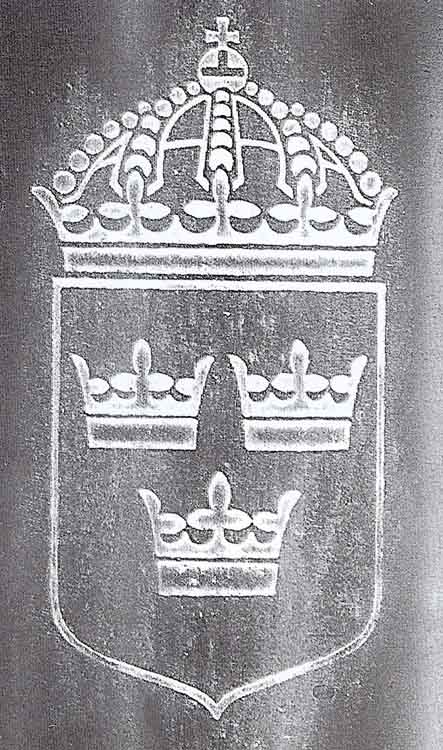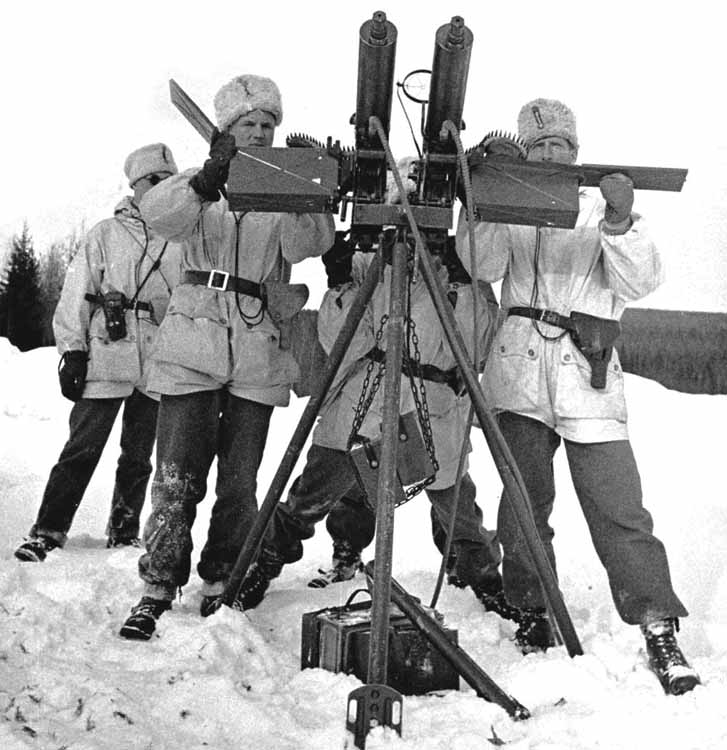
Early Swedish Machine Guns
Sweden was not shy in their attempt to modernize their army at the turn of the twentieth century by equipping it with modern machine guns. The m/95 Maxim, the m/99 Nordenfeldt (Konstruction Bergman-Nordenfeldt) and m/00 Hotchkiss all found a home at one time or another in the Swedish army from 1895 to 1914. From 1914 the m/14 Schwarzlose was adopted and widely used. The first 511 Schwarzlose machine guns were imported from Austria but in 1917 Sweden began making them at the Carl Gustafs Stads Gevärsfaktori (GF) in Eskilstuna. A total of 753 Schwarzloses were built in Sweden between 1917 and 1939.
Enter the System Browning
Sweden had no separate Air Force prior to 1926; instead the Army and Navy each had their own sections of aviation. The Schwarzlose could not be configured to be synchronized to fire through the arc of the propeller and in the 1920s tests were conducted with the M1919 Colt aircraft Brownings that were deemed successful. This ultimately led up to Sweden purchasing a total of 185 M1919s from Colt from 1920 to 1930.
It did not take long for Sweden to recognize the value of Browning’s operating system. The Browning was a simple design, extremely reliable and very cost effective to produce. In 1930, the director of Carl Gustafs Stads Gevärsfaktori noted that they could produce 50 water-cooled M1917A1-type Brownings for the same price as 30 Schwarzlose machine guns, which were still in production at GF. Thus, GF and Sweden embarked on manufacturing machine guns based upon the Browning system. This included the Kulspruta (Ksp) m/22 air-cooled aircraft gun introduced in 1930 and the first water-cooled Browning developed by GF in 1929 as the Ksp m/14-29. This gun was mounted on the m/14 Schwarzlose tripod. Thus, the m/14-29 designation identified the m/14 tripod and the m/29 as the designation of the gun. Between 1930 and 1936, Carl Gustafs Stads Gevärsfaktori produced 274 of the Ksp m/14-29s.
The Kulspruta (Ksp) m/36 mark (ground)
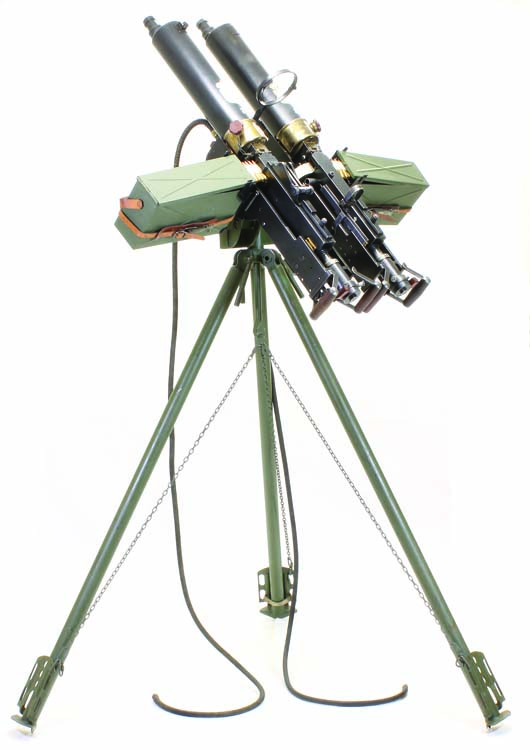
The m/14-29 Browning system water-cooled machine gun was upgraded in 1936 to fire the powerful 8x63mm sk ptr m/32 ammunition. With this powerful, hard-hitting, long range cartridge, the m/14 Schwarzlose mount was deemed unsuitable for long range indirect fire and a new soft mount Lavett was adopted. Gunnar Johnsson, Sweden’s foremost small arms designer, developed the soft mount Lavett. This heavy ground mount had a special cradle buffered by strong springs that guaranteed accuracy by reducing vibration as the gun fired. In conjunction with an elaborate traverse and elevation mechanism and a 5×25 power optical sight, the long range effectiveness for the purpose of indirect fire of the m/36 was phenomenal. Only active Army field units were issued the m/36 machine gun on Lavett soft mounts. Second line units had their m/36 guns mounted on the m/14 Schwarzlose mount because they were easier and cheaper to produce.

While the m/36 was based upon the operating principles of the Browning M1917A1 water-cooled machine gun, there were differences even though the guns appeared similar. The m/36 used spade grips rather than the pistol grip arrangement as found on the M1917A1. If the m/36 mark (ground) was mounted on the m/14 Schwarzlose tripod or the customary infantry tripod, standard spade grips attached directly to the gun were used. If the m/36 was mounted on the single or double buffered soft Lavett mounts then the grips were removed and the spring loaded buffer was added to the back plate. The Spade grips were an integral part of the of the side plates of the cradle. Additionally, the steam tube and valve arrangement, (patterned after the m/14 Schwarzlose system) was relocated to the bottom rear of the water jacket thus eliminating the long steam tube assembly that ran along the axis of the gun along the top of the water jacket as found on the M1917A1. On the muzzle of the m/36 there is an adjustable gas port that assisted in recoil that could be used to increase or decrease the rate of fire.
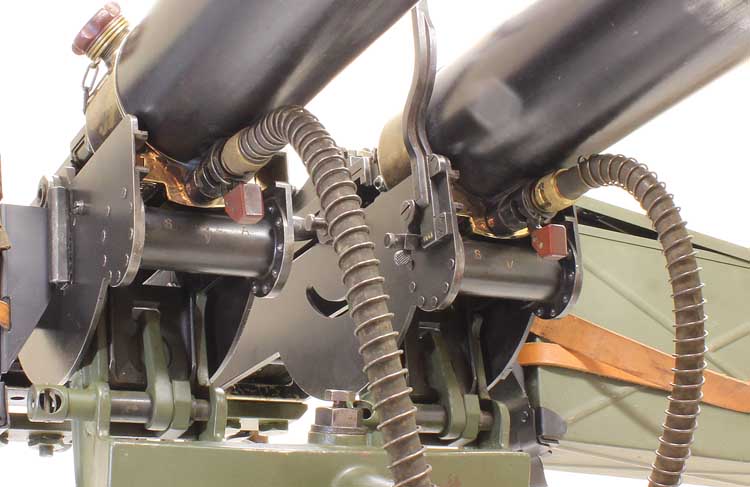
The Kulspruta (Ksp) m/36 lv dbl
An added benefit was the m/32 round had a range of 5.5km (3.4 miles, or nearly 18,000 feet. Thus, in the anti-aircraft role, it could reach high enough to damage aircraft at significant altitudes. This being the case, a twin gun arrangement (lv dbl – twin AA) was created for anti-aircraft work.
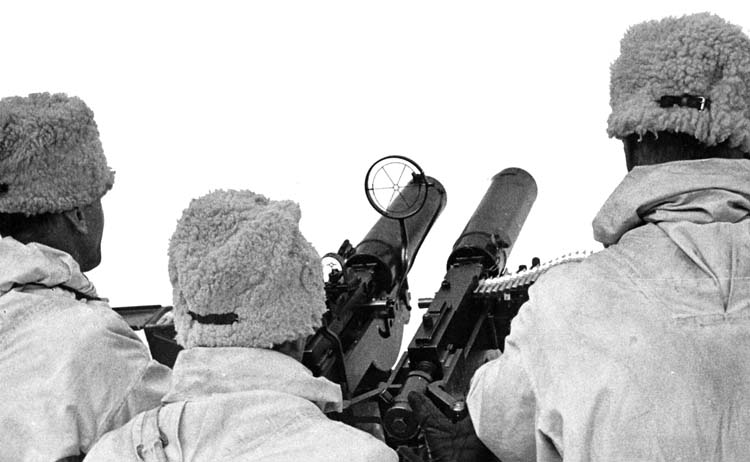
The twin anti-aircraft m/36 guns were not just a matter of mounting two guns in a special cradle on an anti-aircraft tripod. The guns were actually different and made as a pair with the left gun fitted for left-hand feed and the right gun fitted for right-hand feed. The cocking handle of the left-hand gun was on the right side and the cocking handle of the right gun was on the left-hand side. All sighting and aiming was done from the left gun only. The right gun had no sights whatsoever, whether anti-aircraft, front post or rear leaf. Each gun had its own special spring buffer assembly for the right and left guns that were different in that they contained the safety and trigger. The position of the safety and trigger in relation to each gun was different.
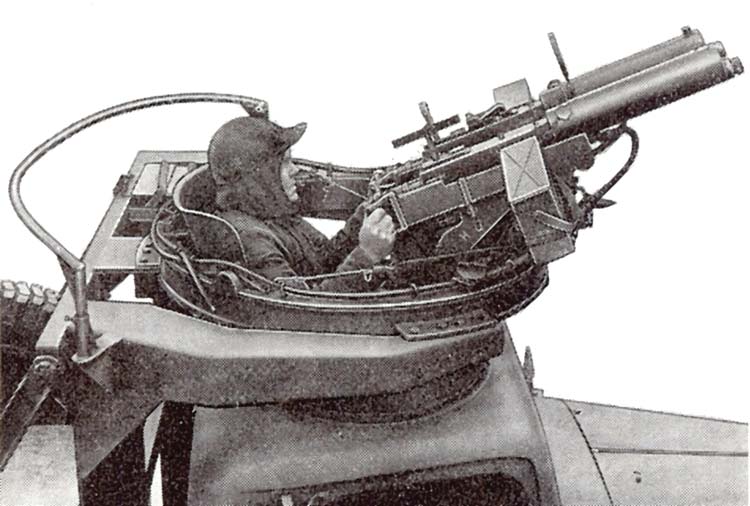
The twin Ksp m/36 lv dbl anti-aircraft arrangement was commonly used atop Volvo trucks and armored vehicles using a ring mount to provide convoy and emplacement protection.
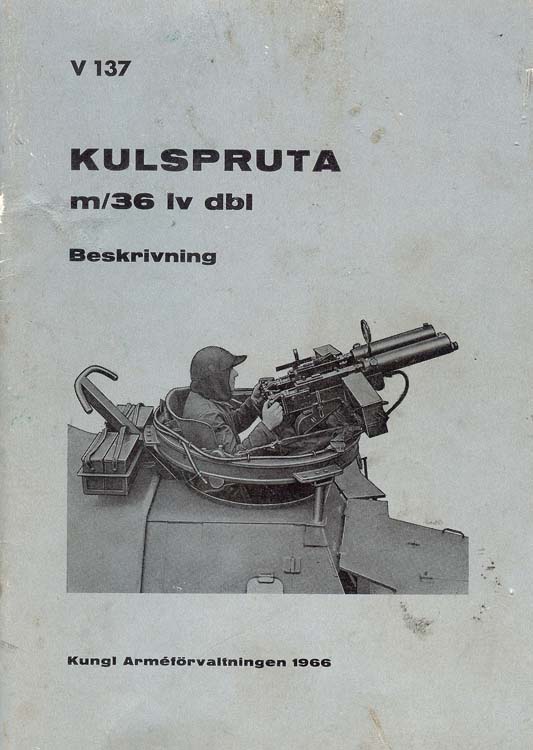
1966 dated manual for the Swedish Kulspruta m/36 lv dbl twin anti-aircraft machine guns showing use on an armored vehicle on the front cover.
The trigger was a red vertical bar that was placed to the outside of the spring buffer tube of each gun, to be operated by the thumb of the right and left hand. Thus each gun was operated independently from each other. The left or the right could be fired alone or both together depending on target, ammo supply, operability, and operator preference. The safety was a spring loaded knob mounted on a ring to the inside on the spring buffer tube. By pulling up the knob and rotating the ring around the outside of the spring buffer tube, a stop was positioned in front of the trigger to prevent trigger depression. Again, each gun was operated independently.
Twin AA Cradle and Tripod
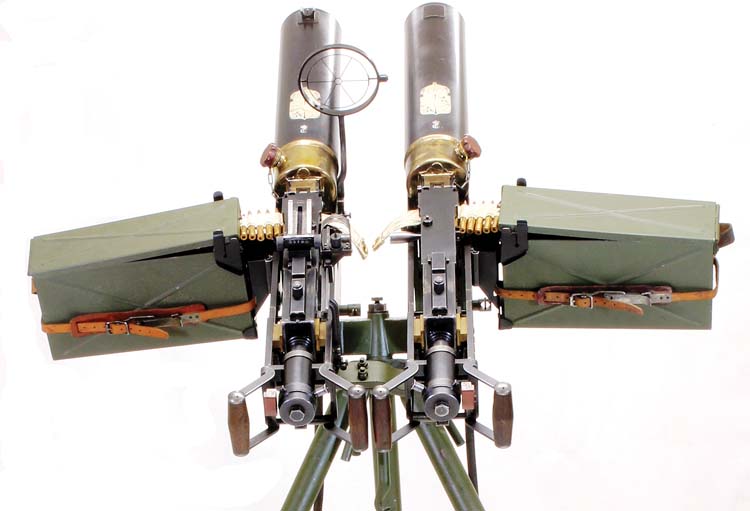
The Sammansättning anti-aircraft tripod accepting a single or double gun cradle is a special long-legged affair to allow for anti-aircraft fire while standing. Chains are used to lock the tripod down for extra rigidity during firing. If conditions were such that it was not feasible to use the chains to lock the tripod down (e.g. in snow), weights, such as rocks or full ammo cans, could be slung in the looped chains to gain some rigidity to the mount.
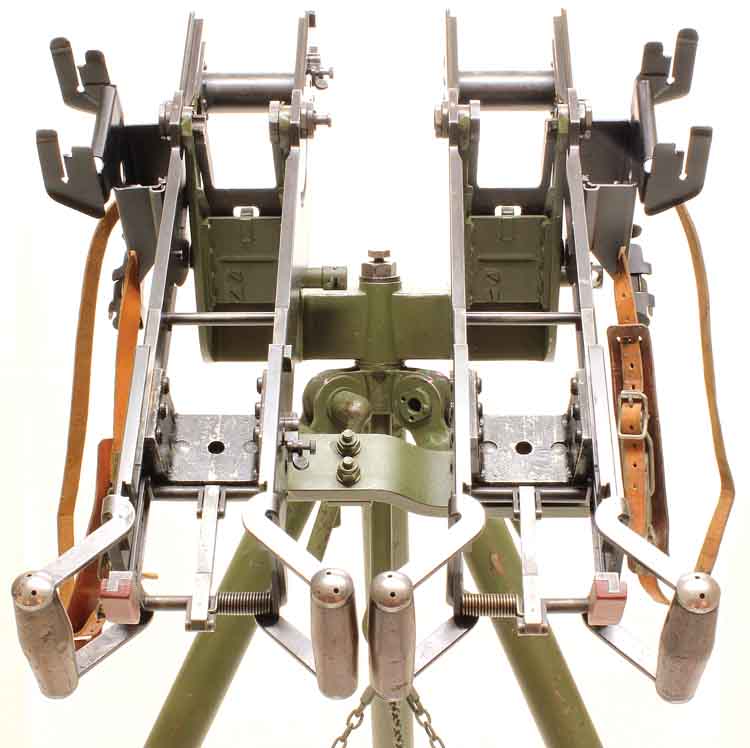
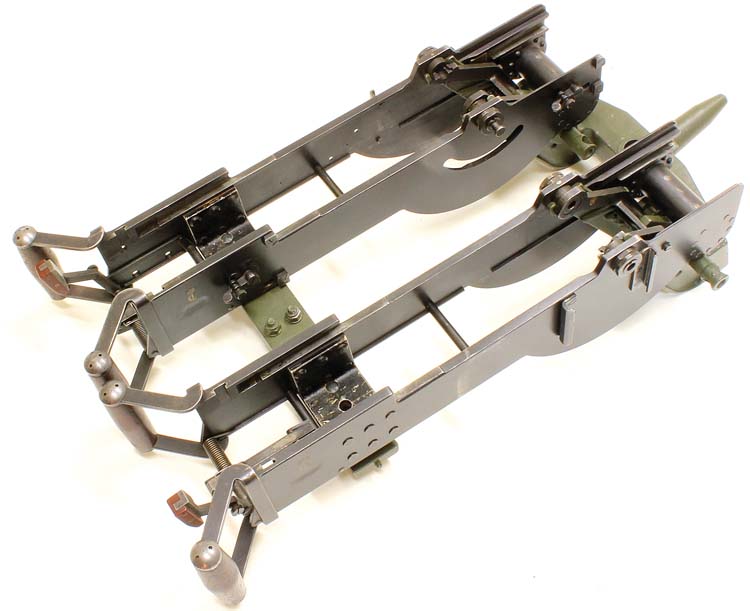
A special soft twin cradle arrangement was used for the twin anti-aircraft m/36 guns. The cradle frame consists of two single soft cradles, one for each gun. The two cradles were held rigidly parallel to each other by the twin cradle head at the front that allows mounting to the tripod and elevation, and a bolted metal cross beam at the rear. Depending on whether a left or right hand arrangement, provisions to hold the ammunition boxes to each side gun cradle and the spade grips for each gun that also contained the remote trigger was determined by whether a right or left side set-up. The front of each cradle is attached to the tripod head so as to allow elevation. The tripod head socket fits into a pivot point on the tripod that allows unrestrictive 360 degree traversing.
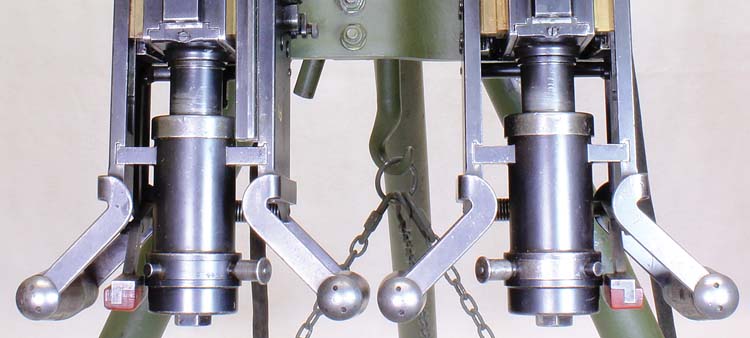
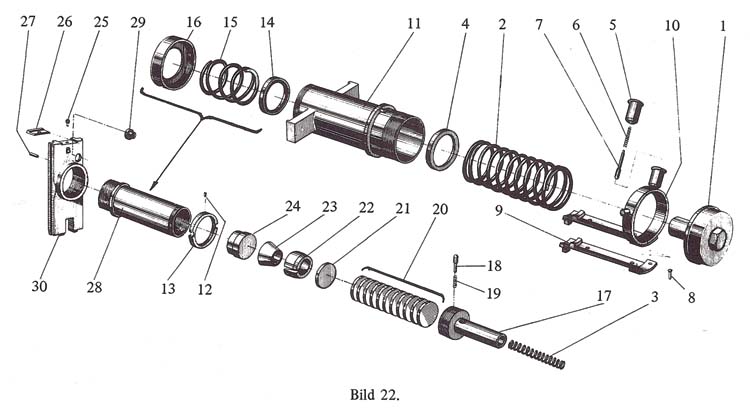
In addition to the anti-aircraft tripod, the twin m/36s were also commonly placed on trucks or armored vehicles in a ring mount providing a 360-degree area of protection. These were often fitted on top of the driver’s cab on a number of different Volvo truck models. A ground infantry tripod, the Värnlavette m/41 tripod that accepted a single gun or a twin-gun cradle was also available though the twin anti-aircraft version of m/36 ground mount was rarely encountered.
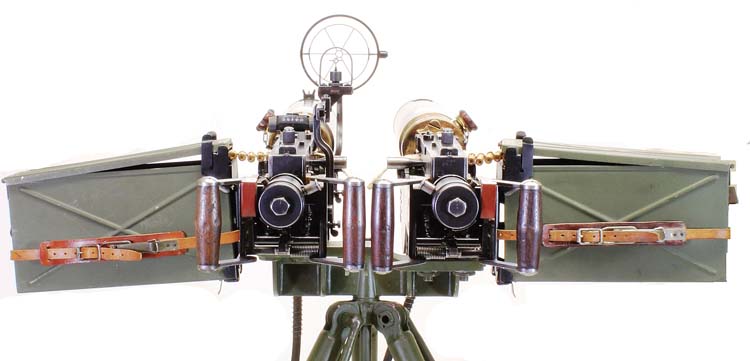
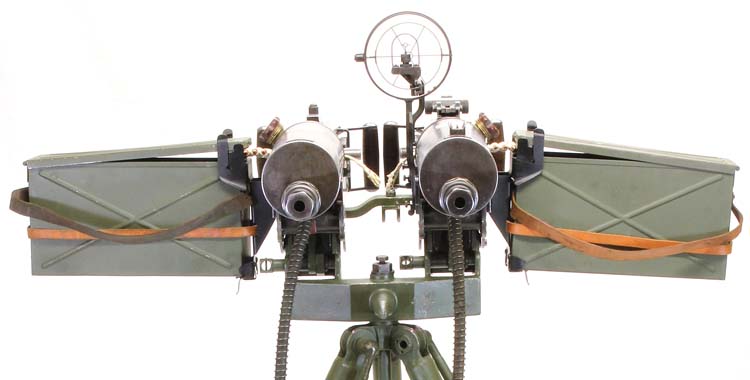
Production
With the very real possibility of war looming on the horizon in the late 1930s, the production capacity of Carl Gustafs Stads Gevärsfaktori (GF) was pushed to its limits due to orders for weapons of all sorts of rifles, light machine guns and heavy machine guns. In December, 1939, negotiations were held with Telefon AB L.M. Ericsson (LME) concerning supplementing production of the m/36. LME was already involved in manufacturing some parts for the m/36 as early as 1938 and by early 1940 was manufacturing many m/36 components thereby easing the pressure on GF and by 1941 were producing 15 machine guns per day. In all, Carl Gustafs Stads Gevärsfaktori (GF) produced 8,025 m/36s and L.M. Ericsson (LME) produced 5,361 m/36s.
The water-cooled m/36 was primarily manufactured by Carl Gustafs Stads Gevärsfaktori (GF) from 1937 to 1944 while L.M. Ericsson (LME) produced guns in the three year period of 1940-1942.
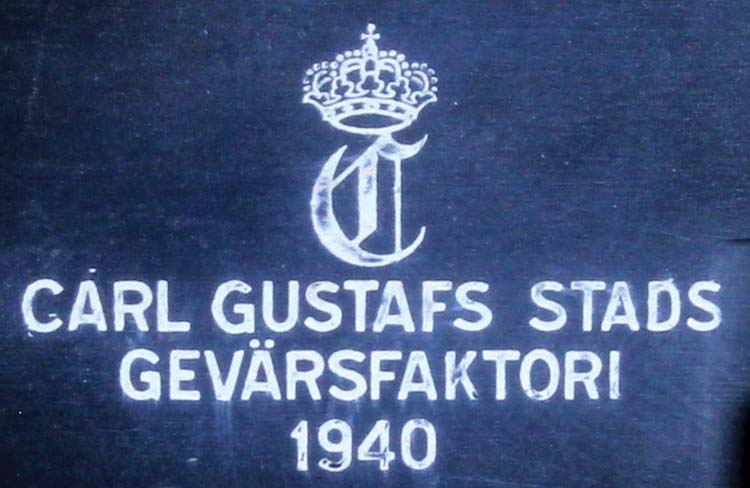
- The m/36 mark (ground) MG: GF and LME produced 6,615 guns with the mount m/36. Another 973 were made by GF and LME without mount, used with the m/14 Schwarzlose mount.
- The m/36 lv (AA single) MG: GF and LME produced 406 guns.
- The m/36 lv dbl (Twin AA guns): Made in pairs, GF and LME produced 5,392 guns representing 2,696 pairs.
A unique aspect of the Swedish m/36 water-cooled machine gun is that both manufacturers applied a relatively large, ornate but different Swedish crest to the top of the water jacket. Guns made by Carl Gustafs Stads Gevärsfaktori (GF) can be easily identified by the large intricate roll-stamped crowned shield that is divided into four sections by a cross, with two lions and two groups of three crowns each in the segments.
The m/36 as made by L.E. Ericsson also had a roll-stamped design on top of the water jacket but was completely different from GF and thus an easily identifiable variation. It consisted of a simpler crown atop a single shield with three crowns in it.
Ammunition and Feeding
The m/36 used cloth ammunition belts similar to typical Browning cloth belts. Each belt contained 250 rounds and was loaded into a metal ammunition box. The ammunition box had a metal top hinged at the end for full opening. Riveted to each end is a long leather strap that serves as a carrying handle. There is an ammunition box holder adapter that affixes to the left side of the cradle for a single gun, or a left and right for the twin m/36s for the ammunition boxes to affix to for the twin guns. These ammunition box holders have an adjustable leather strap that goes around the ammunition box to hold it securely in place during firing.
The m/36 was chambered in three different rounds in its lifetime, each time new barrels, bolts and cartridge stops being supplied as the rounds changed and improved. The m/36 was originally chambered in the m/94 round-nosed loading of the 6.5x55mm Swedish service cartridge. Then the m/32 8x63mm cartridge loaded with a 220gr bullet to the same overall length as the U.S. .30-06 with 56 grains of nitrocellulose powder that produced a muzzle velocity of 2,493 fps. This beefed-up .30 caliber cartridge allowed for accurate extreme long range shooting especially when mounted on the Lavett soft-mount single or double tripod. In the post-World War II years, the Swedish Army adopted the Belgian FN MAG in 1958 and the m/36 was then transferred to second-line units. Sweden then joined NATO and adopted the H&K NATO caliber G3A3 (AK4 in Sweden) and in 1966 the Swedish Army switched completely to NATO calibers. This included all the m/36s in secondary units and they were rechambered to the 7.62mm (.308) NATO round. The m/36 remained on active service in the Swedish Army until the 1990s when finally declared obsolete and retired from service in 1995.
Accessories
There were a number of accessories associated with the m/36 that included a tool and spare parts chest that contained just about everything needed to keep the gun running, a belt loading machine similar to the typical Browning-type of cloth belt loader, water jacket carrying strap to carry the gun when the water jacket is hot, wooden box containing the anti-aircraft sights, water carrying/condensing can, spare barrel, spare barrel carrier, cleaning rod, ammo box holder brackets that attach to the single or double soft mount cradle, leather support straps for hanging ammo boxes and an expended cartridge shell bag. A 5×25 power optical sight in a fitted leather case was also available. The optical sight was not used or issued with the twin anti-aircraft m/36s but was issued and used when the m/36 (single or double) was used on the soft ground mount.
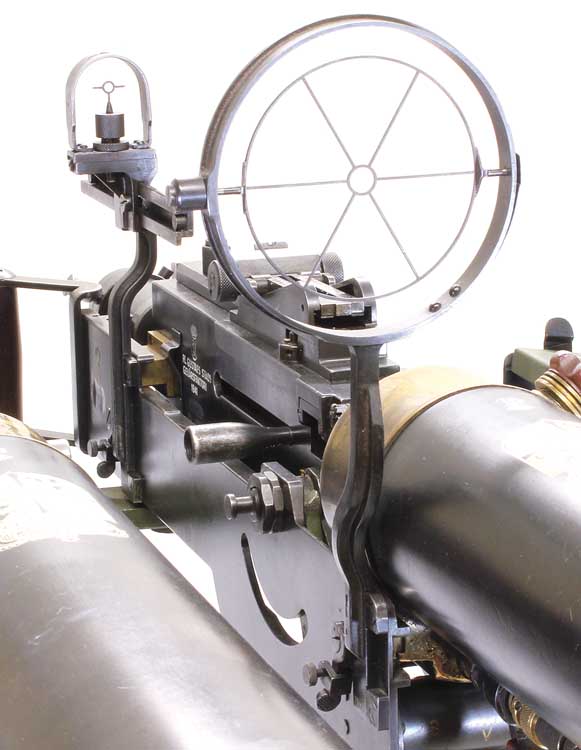
The front and rear anti-aircraft sights at attached to the left gun cradle – not to the gun.
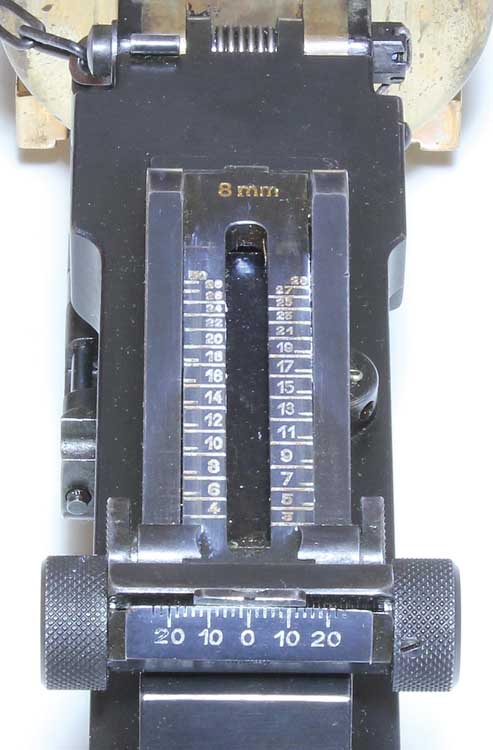
The leaf sight is adjustable from 300 to 3,000 meters and is also adjustable for windage. This sight is on the left gun only.
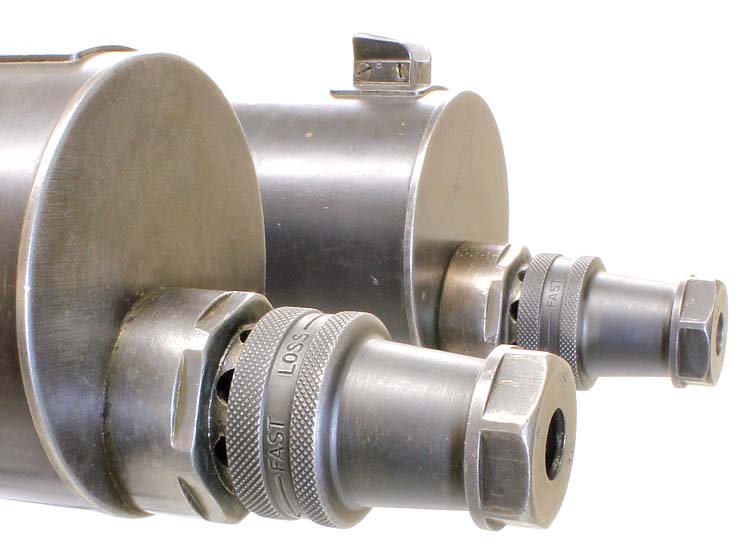
The muzzle booster of the m/36 is adjustable by exposing more or less of the gas escape holes. Adjusting allows a faster or slower rate of fire.
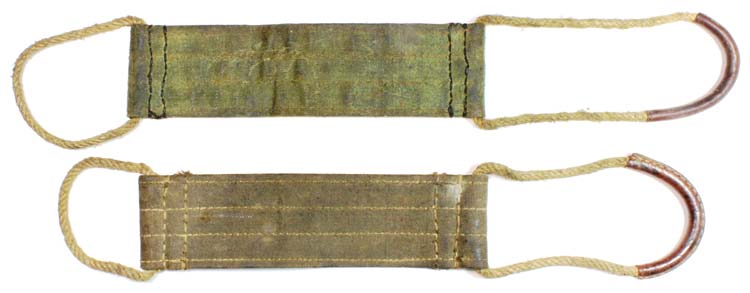
Pair of canvas and rope slings to facilitate carrying the water-cooled m/36s when they are hot replacing the need for asbestos gloves. The large loop goes through the smaller loop that then provides the means for carrying.
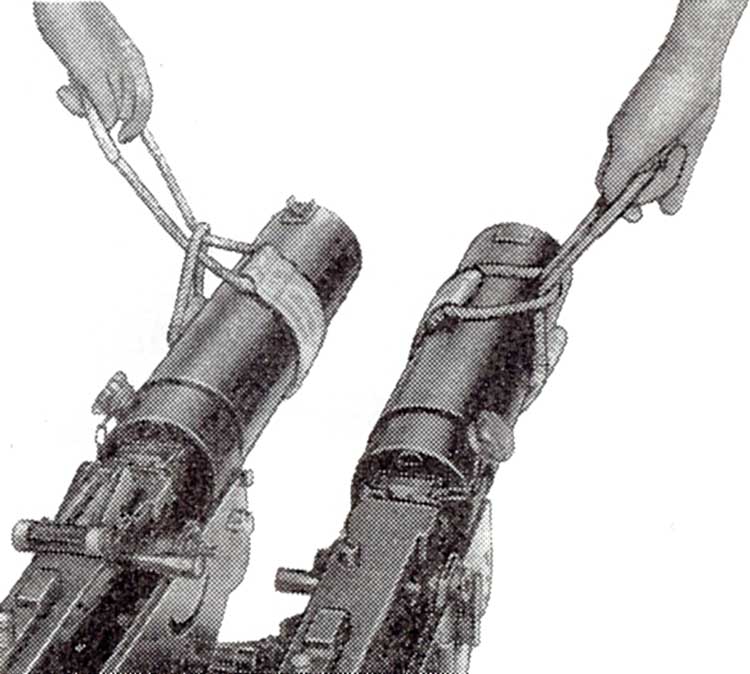
Illustration from the Ksp m/36 manual showing the proper method of using the water-jacket carrying straps.
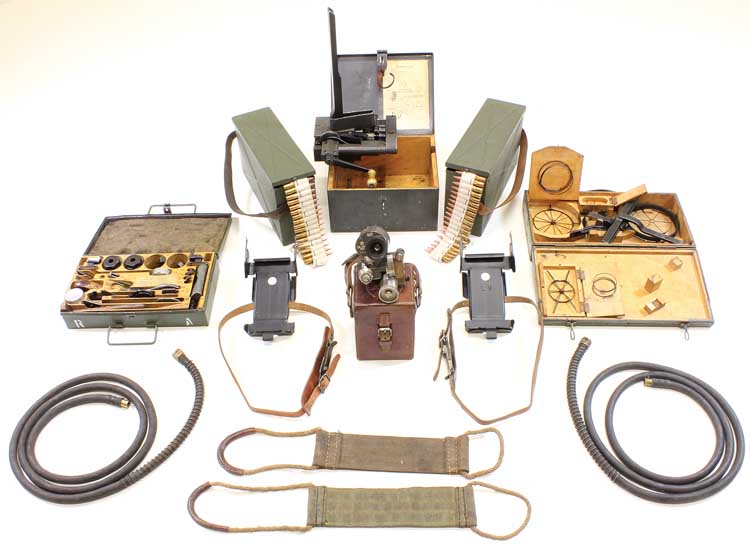
Accessories for the Ksp m/36 included a belt loading machine, tool and spare parts box, 8×25 optical sight, box with spare anti-aircraft stadia and ring sights, ammunition box holders with leather support straps, water-jacket carrying straps and water condensing hoses.
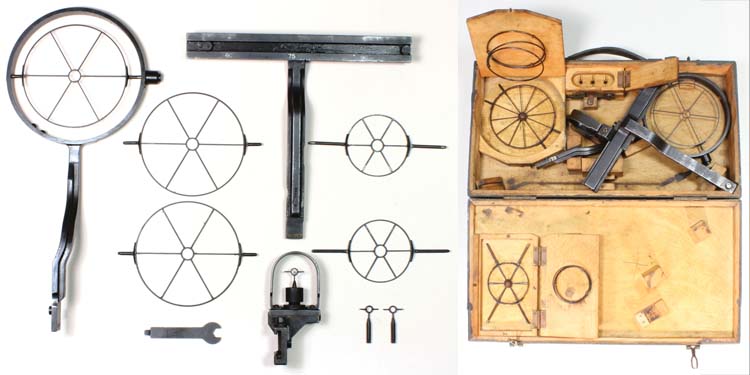
The anti-aircraft sight box contains the mounting fixtures for the front and rear sights as well as extra ring and stadia sights.
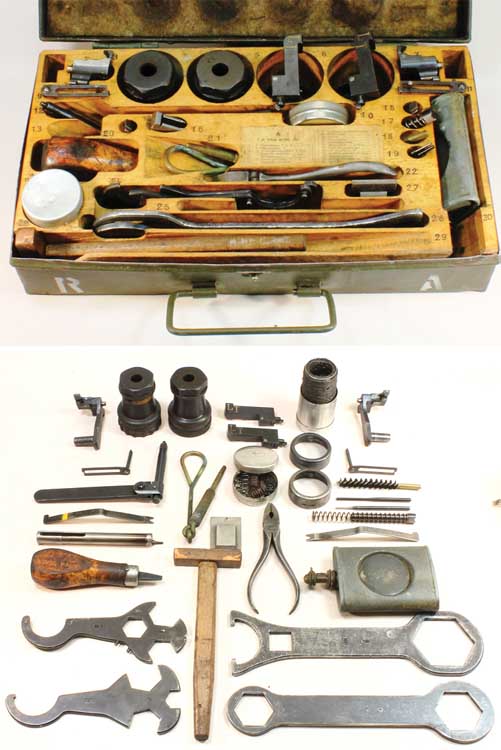
The spare parts and tool box has just about everything you need to keep the Browning system Swedish Kulspruta m/36 machine guns running.
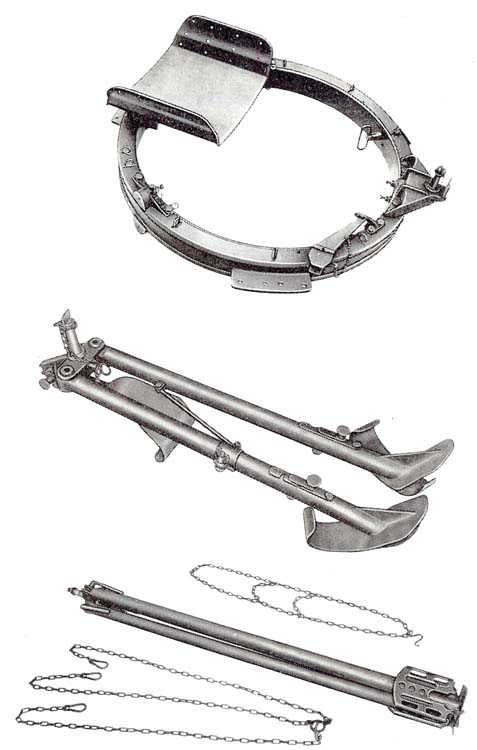
From the Kulspruta manual, three types of mounting for the Ksp m/36: ring mount (top), Värnlavette m/41 tripod (middle) and anti-aircraft tripod (bottom).
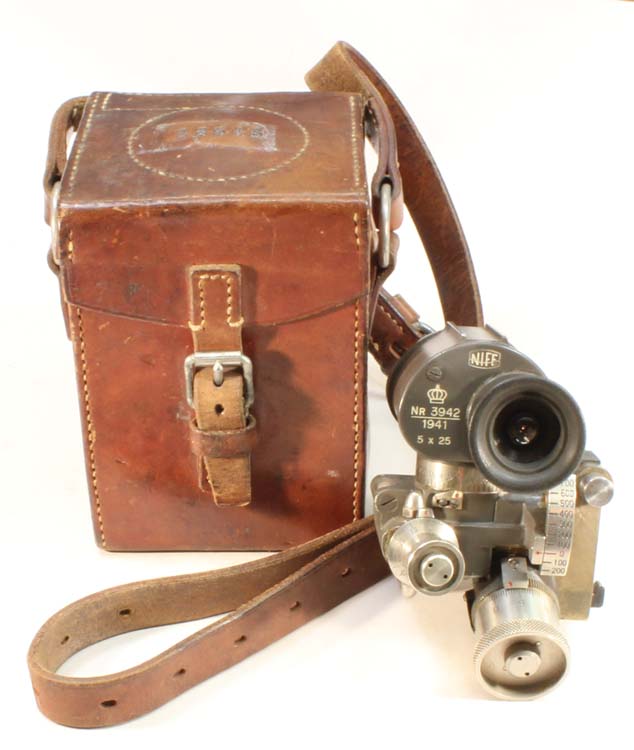
The 5×25 optical sight came fitted in its own leather carrying case and was issued to ground units only. There were at least three manufactures of the optical sights to include Navigation, Berlin; Spindler & Hoyer, Gottingen, Sweden and NIFE as shown here, dated 1941.
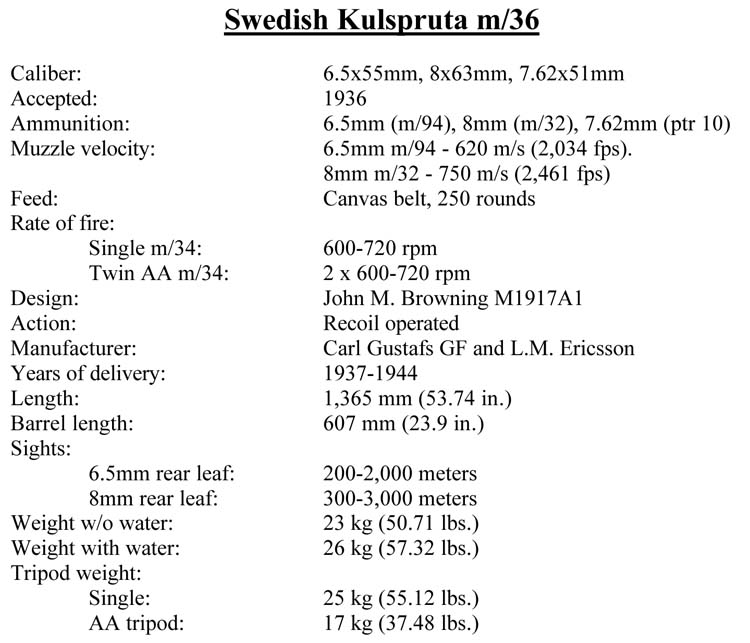
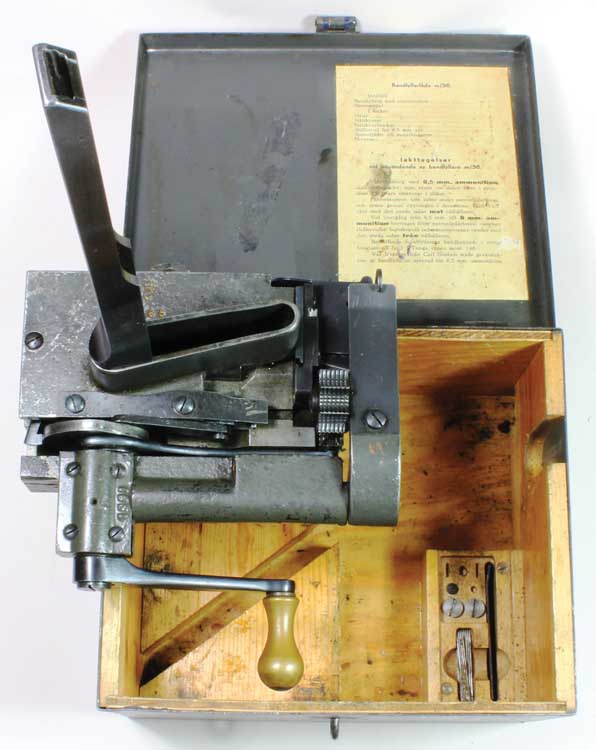
The belt loader is of the Browning type to load 250-round canvas belts. The loader comes complete with spare parts including needles.
| This article first appeared in Small Arms Review V15N5 (February 2012) |





